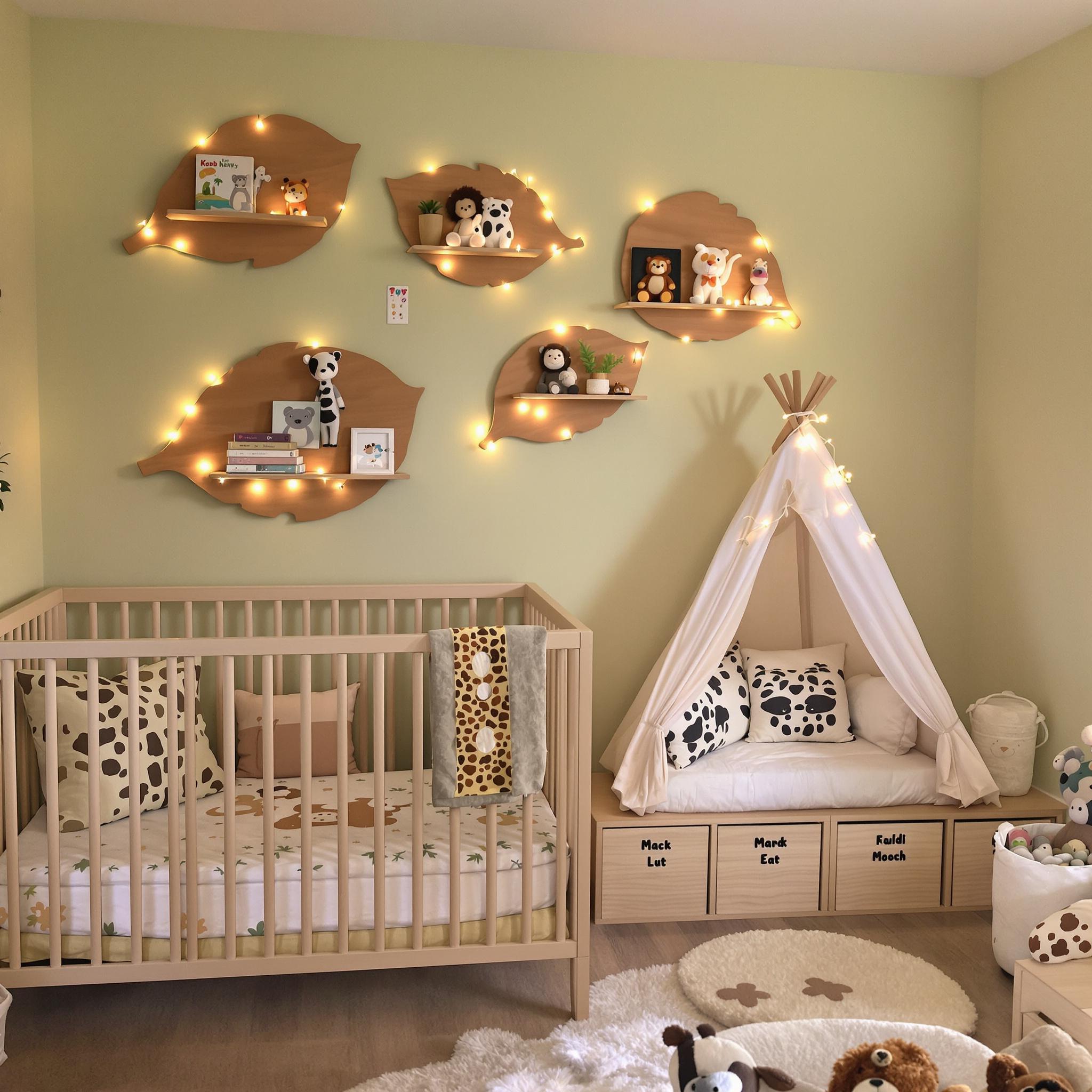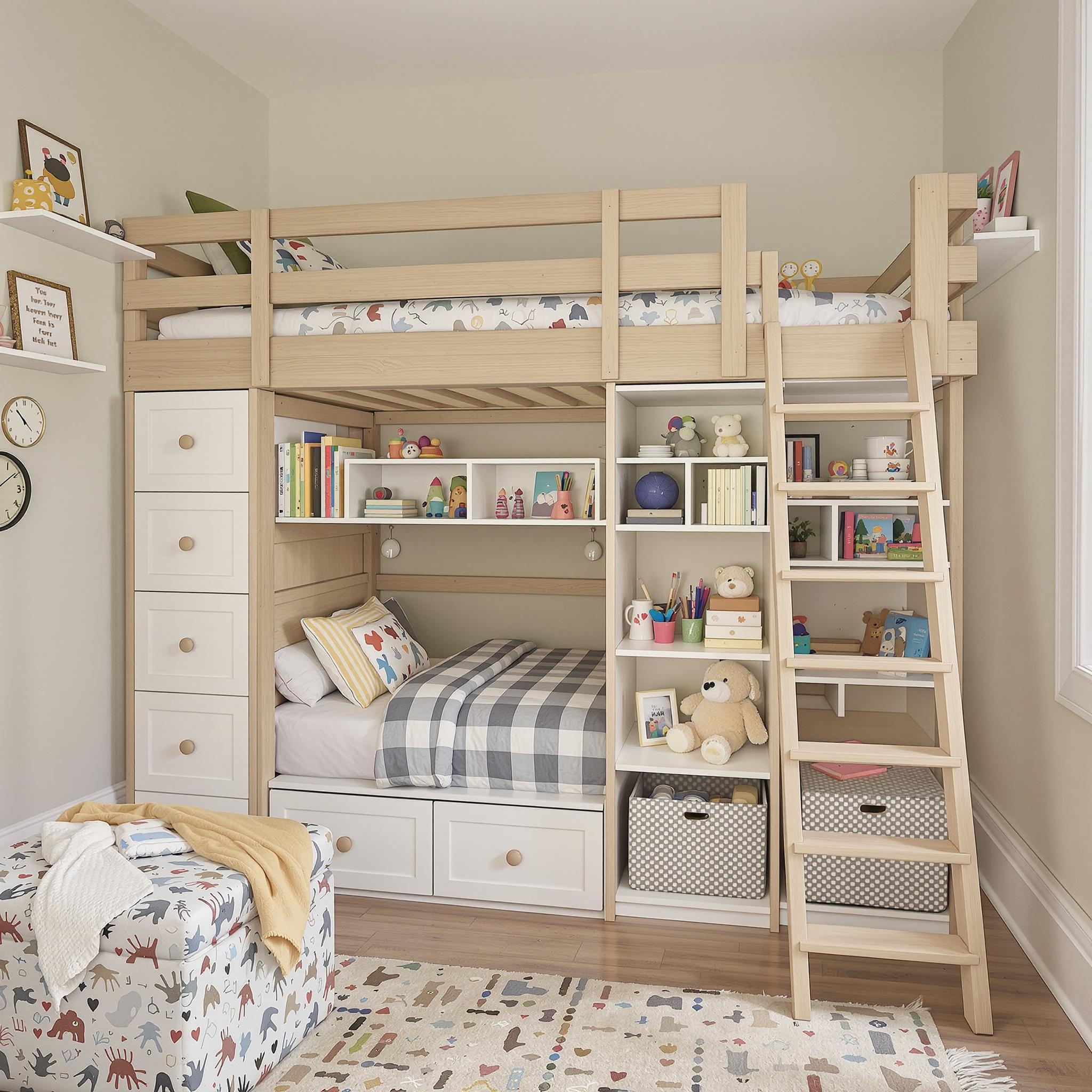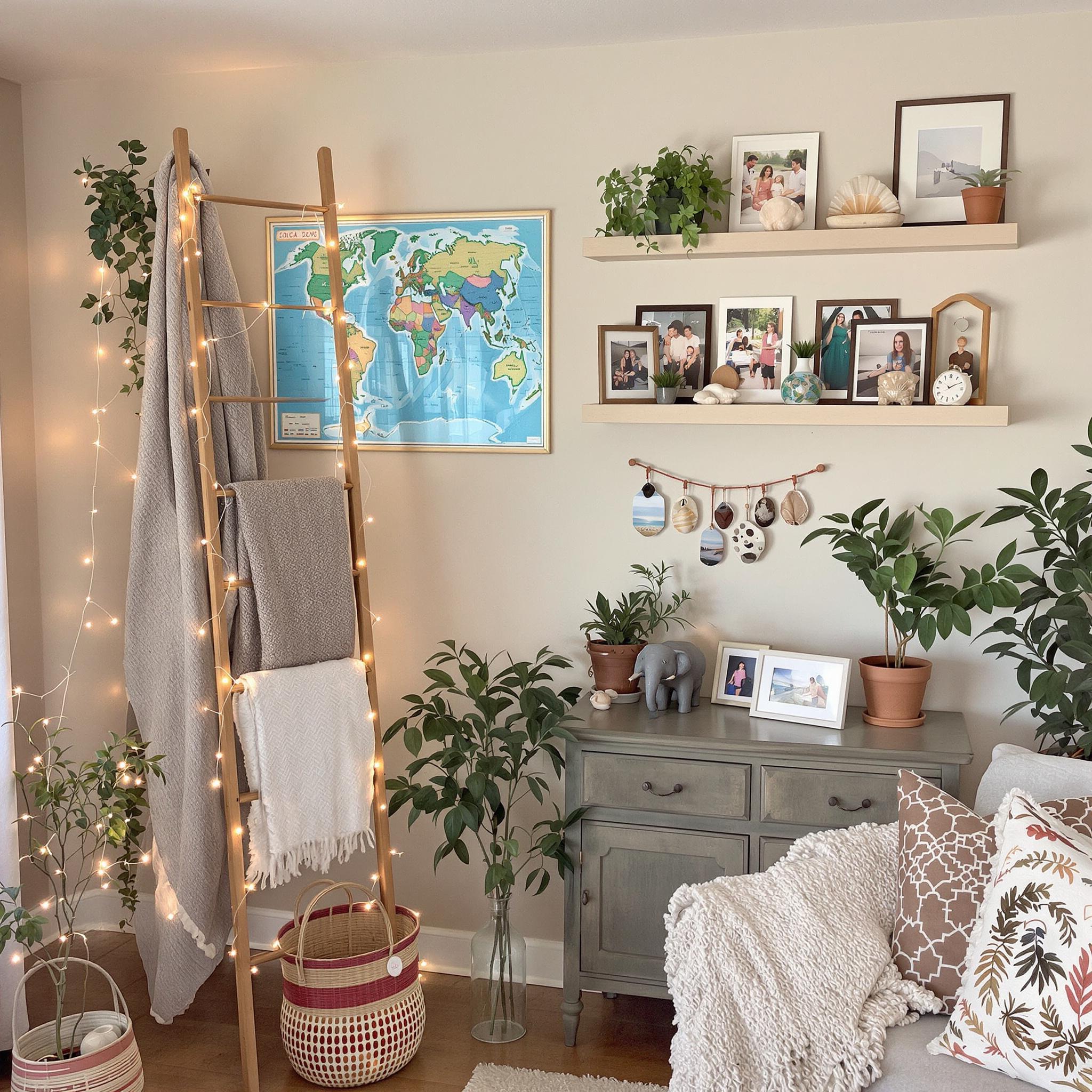Designing a Kid-Friendly Aesthetic: Where to Start
Creating a space for kids means blending fun with function. It’s not just about looks. Safety, comfort, and ease of use matter too.
Start by thinking about your child’s personality. Do they love bold colors? Or are they drawn to calm tones? Let their preferences guide you.
- Pick a theme that grows with them.
- Choose durable materials that handle wear and tear.
- Add elements that spark creativity.
For example, I once designed a room with a jungle theme. My son loved animals, so we added leaf-shaped shelves and animal prints. The decor stayed fun for years.
Choosing Colors That Work
Color sets the mood in any room. Bright shades like yellow or blue feel playful. Neutral tones like gray or beige add balance.
Avoid going overboard with bold colors. Too much can overwhelm. Instead, mix brights with neutrals for a balanced look.
Consider painting one wall a feature color. This adds interest without taking over the room. Soft greens or blues work well for calming spaces.
Furniture That Grows With Your Child
Kids grow fast. Furniture should keep up. Look for pieces that adjust or adapt as they age.
Convertible cribs turn into toddler beds. Desks with adjustable heights last through school years. These choices save money and space.
Storage is key. Kids have lots of stuff. Choose furniture with built-in drawers or shelves. Bins and baskets also help keep clutter under control.
I learned this the hard way. Without enough storage, toys quickly took over our living room. Adding a toy chest solved the problem.
Making Safety a Priority
Safety comes first in kid-friendly design. Sharp edges and small parts are hazards. Choose rounded furniture and secure heavy items to walls.
Cover outlets and use cord organizers. Keep harmful items out of reach. Simple changes make a big difference.
Soft rugs prevent slips and falls. Non-toxic paints and materials protect your child’s health. Always check product labels.
Balancing Fun and Practicality
A kid-friendly space should be fun but also practical. Decorate with items that serve a purpose.
Chalkboard walls let kids draw without ruining furniture. Play mats double as seating. Multi-functional pieces save space.
Lighting matters too. Bright lights help with homework. Dimmer options create a cozy bedtime vibe.
One mom I know added a reading nook. Her kids loved it. A small tent and string lights made it magical.
Involving Kids in the Process
Kids feel proud when they help design their space. Ask for their input on colors and themes.
Let them pick accessories like pillows or curtains. Personal touches make the room special.
Set boundaries if needed. Offer two or three options to keep things manageable. This prevents overwhelm.
My daughter chose her own wall decals. She felt excited about her room. It became her favorite spot in the house.
Adding Creative Touches
Small details make a big impact. Wall art, rugs, and throw pillows add charm.
DIY projects are budget-friendly. Paint old furniture or sew pillow covers. These add personal flair.
Themed bedding ties the room together. Cars, stars, or flowers can match the overall design.
Try a gallery wall. Mix photos, art, and quotes. It’s a fun way to display memories.
Keeping the Space Organized
Clutter makes rooms feel chaotic. Smart storage keeps things tidy.
Label bins for easy cleanup. Use clear containers for toys and books. Kids can see what’s inside.
Rotate items seasonally. Store off-season clothes or toys out of sight. This keeps the room fresh.
A friend of mine uses under-bed storage. It’s perfect for extra blankets or seldom-used toys.
Planning for the Future
Kid-friendly design should adapt as they grow. Avoid overly childish themes. Opt for timeless styles instead.
Neutral furniture works for all ages. Add trendy elements with decor. Pillows and rugs are easy to swap out.
Think long-term. A well-designed space saves time and money. It grows with your child’s needs.
My oldest switched from a race car bed to a simple frame. The rest of the room stayed the same. The update was quick and affordable.
Maximizing Space with Multi-Functional Furniture
Let’s be honest—kids’ rooms are usually tiny. But they don’t have to feel that way. One of my go-to tricks is using furniture that does more than one thing. These pieces are like the Swiss Army knives of decor. They’re practical and save space. Loft beds are a great example. I once visited a friend, and their kid had a loft bed with a desk underneath. The room felt twice as big because everything was organized.
If loft beds aren’t your thing, there are other options. Bunk beds with storage drawers are fantastic. You can hide clothes, toys, or seasonal stuff in them. Trundle beds are perfect for sleepovers without hogging space during the day.
And it’s not just beds. Ottomans that double as toy chests or benches with hidden storage are lifesavers. Who wouldn’t want furniture that works overtime? It’s like getting two things for the price of one.
- Loft Beds: Add vertical space and keep floors clear.
- Bunk Beds with Storage: Great for shared rooms.
- Ottoman Toy Chests: Perfect for small spaces.
Pro tip: Measure your room before buying anything. Trust me, nothing’s worse than loving something only to find it doesn’t fit through the door.
Clever Storage Solutions That Actually Work
We’ve talked about furniture, but storage is just as important. Keeping a kid’s room tidy feels impossible sometimes. Toys pile up, art supplies multiply, and shoes? Don’t even get me started. But smart storage solutions can help.
Wall shelves are a game-changer. They keep stuff off the floor and let kids display their favorite things. My niece loved her “special shelf” for showing off stuffed animals. It made cleanup a little easier since she felt proud of her space.
Baskets and bins are another must-have. Label them clearly—or use pictures for younger kids. I taped photos on my son’s bins, and it worked wonders. He’d put cars in the “car bin” and blocks in the “block bin.” Sure, socks still ended up under the bed, but hey, progress.
Under-bed storage is also awesome. Most beds waste space underneath. Slide-out drawers or flat bins can hold out-of-season clothes or bulky items. Once, I found an old Halloween costume under my daughter’s bed months later. It felt like discovering buried treasure (minus the value).
- Wall Shelves: Store and display at the same time.
- Labeled Bins: Teach kids to stay organized.
- Under-Bed Storage: Use every bit of space.
If you’re crafty, try DIY projects. Turn mason jars into pencil holders or use old crates as organizers. Pinterest has tons of ideas if you’re into that.
Making Cleanup Fun (Yes, Really)
What if cleaning up didn’t feel like a chore? Turns out, making it fun actually works. Kids love routines and play, so combine the two.
Turn tidying into a game. Set a timer and see how much they can clean before it goes off. Or assign points for tasks—five points for books, ten for folding blankets—and let them earn a small prize. My nephew thought he was in the Olympics, complete with cheers and victory laps.
Music helps too. Play upbeat songs during cleanup time. Suddenly, picking up toys feels like a dance party. One week, my kids played the same song over and over. It drove me nuts, but the floor stayed clear, so I couldn’t complain.
Here’s a sneaky trick: involve your kids in organizing. Let them pick colorful bins or decide where to store their action figures. Giving them a say makes them more likely to keep things tidy.
Small Changes, Big Impact
Sometimes, simple changes make the biggest difference. Closet organizers, for example, can teach independence. Low-hanging rods or open cubbies let kids grab their own clothes. I’ll never forget the first time my daughter picked her outfit herself. It was mismatched and sparkly, but she was so proud.
Hooks are underrated too. Install them near the door for backpacks or jackets. This keeps clutter off the floor and teaches responsibility. Color-code them in shared rooms to avoid arguments.
Lighting matters. Bright, warm lights make a room inviting, while task lighting helps focus. I added fairy lights above my son’s bookshelf, and suddenly, he loved reading before bed. Tiny bulbs, big impact.
Thinking Long-Term
Finally, think ahead. Kids grow fast. Choose furniture and storage that can grow with them. Adjustable shelves, modular desks, and neutral bins work for toddlers and teens alike.
I learned this the hard way. We bought a cute pastel dresser for my daughter as a baby, but she hated it by age five. Lesson learned: stick with timeless designs.
Sustainability matters too. Pick durable materials and eco-friendly products. This reduces waste and sets a good example. Teaching kids to care for their stuff now pays off later.
So there you go—a bunch of ideas to tackle furniture and storage in kids’ rooms. Whether you’re tight on space or just trying to stay organized, these tips should help.
Adding Creative Themes and Personalized Touches to Make Your Space Truly Yours
You know that moment when a house starts feeling like a home? It’s not about the furniture or paint colors. It’s the little things—those creative themes and personal touches—that make it yours. I figured this out during a chaotic weekend cleaning spree. I was organizing my bookshelf, which was a total mess, and found a tiny ceramic elephant my grandma gave me years ago. It wasn’t fancy, but putting it front and center made the whole shelf feel like me. That’s the magic of personalization.
You don’t need to redo your entire house to make it special. Small changes can have a big impact. Here are some ideas to get started:
Start with a Story: Thematic Decor That Speaks to You
Ever walked into someone’s place and felt like you were stepping into their life? That’s what thematic decor does. Love traveling? Turn a wall into a “passport” of your adventures. Hang a map, pin postcards, or display souvenirs like shells or handmade crafts. If you’re more into cozy vibes, go vintage with antique frames, retro posters, or a record player spinning your favorite tunes.
Themes don’t need to be loud or overdone. Subtle nods work too. I once helped a friend design her living room around her love for plants. We didn’t go full jungle—just added potted plants, botanical prints, and earthy tones. The result? A calm space that felt like her.
- Pick a theme based on what you love: music, art, nature, movies, etc.
- Mix textures and colors to add depth.
- Don’t forget lighting—it sets the mood.
Personalized Touches: Where Memories Meet Design
Now, let’s talk about adding those special details. Family photos, handwritten notes, or DIY projects make a space feel alive. Remember that Pinterest board you saved forever ago? Dust it off and try something hands-on. Paint a canvas, sew pillow covers, or turn old jars into candle holders. Making something yourself feels amazing.
Here’s a funny story: Last year, I turned an old wooden ladder into a blanket rack. At first, it looked terrible. But after sanding, painting, and adding fairy lights, it became one of my favorite pieces. Imperfections aside, it’s mine—and that’s what matters.
Not into DIY? No problem. Display heirlooms, frame concert tickets, or showcase artwork from friends or local artists. These pieces spark conversations and remind you of good times.
Actionable Tips for Bringing It All Together
Ready to dive in? Here’s how to do it without getting overwhelmed:
- Start small: Focus on one area—a shelf, a corner, or a single wall.
- Balance is key: Mix bold pieces with neutral ones to avoid chaos.
- Layer textures: Add rugs, throws, or cushions for warmth.
- Involve others: Ask family or roommates to chip in ideas or mementos.
- Rotate seasonally: Change decor every few months to keep things fresh.
Pro tip: Don’t aim for perfection. Some of the best spaces grow naturally over time. Like that creaky chair at your grandma’s house—it wasn’t perfect, but it had character. Embrace quirks!
Final Thoughts: Your Home, Your Canvas
Your home should reflect who you are—a mix of memories, dreams, and everyday happiness. Whether you’re creating a gallery wall or arranging your favorite books, every choice adds meaning. Inspiration can hit anytime—even while binge-watching TV or scrolling social media. Write it down!
Take a breath, trust your gut, and let your creativity flow. Your home isn’t just four walls. It’s a sanctuary, a playground, and a work of art waiting to happen.
FAQs About Creative Themes and Personalized Touches in Home Decor
1. How do I choose a theme for my home?
Pick something that excites you. Love nature? Go green and woodsy. Into minimalism? Stick to clean lines and neutrals. There’s no wrong answer—it’s all about what speaks to you.
2. Can I mix different styles together?
Yes! Mixing styles creates an eclectic look. Just keep one thing consistent, like color or material, to tie it all together.
3. What if I’m not artistic enough for DIY projects?
Start simple. Paint plain vases or stencil quotes on pillows. Online tutorials can guide you step-by-step.
4. How do I personalize rented spaces?
Use removable wallpaper, command hooks, and freestanding shelves. They let you express yourself without breaking lease rules.
5. Is it okay to use sentimental items as decor?
Absolutely! Sentimental items add emotional value. Frame photos, display heirlooms, or incorporate gifts from loved ones.
6. How often should I update my decor?
There’s no rule. Some people change things seasonally, others wait until they feel bored. Trust your instincts.
7. What’s the best way to arrange photo displays?
Experiment before committing. Use painters’ tape to outline frames on the wall or lay them on the floor to check spacing. Symmetry feels formal; asymmetry feels fun.
8. Should I invest in expensive decor pieces?
Not always. Spend on staples like sofas or tables, but accessories can be budget-friendly. Thrift stores are great for unique finds.
9. How do I avoid cluttering my space?
Follow the “one in, one out” rule. For every new item, remove something old. Keep storage organized.
10. Where can I find inspiration for creative decor ideas?
Check Pinterest, Instagram, magazines, blogs, or even stylish neighborhoods. Inspiration is everywhere—you just have to notice it.



